Sales of parbaked bread in North America are estimated at USD 5.2 billion in 2025, with projections indicating a rise to USD 7.7 billion by 2035, reflecting a CAGR of 4.0% over the forecast period. This growth is driven by increasing consumer demand for convenience foods, evolving bakery offerings, and the expansion of modern retail channels.
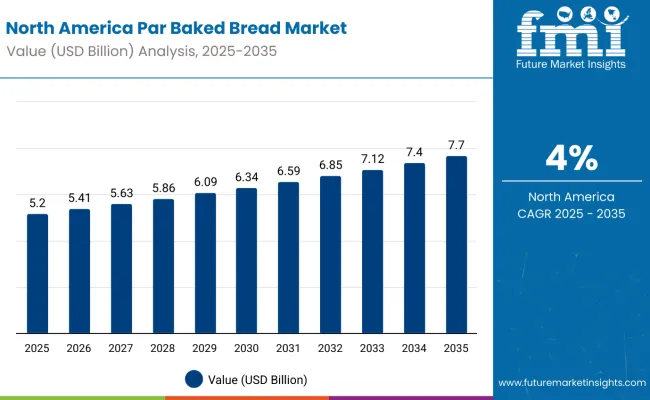
| Metric | Value |
|---|---|
| Estimated Size (2025E) | USD 5.2 billion |
| Projected Value (2035F) | USD 7.7 billion |
| CAGR (2025 to 2035) | 4.0% |
By 2025, per capita consumption is concentrated in urban centers with high retail penetration, and projections indicate steady growth by 2035 as bakery chains and foodservice establishments continue to adopt par baked bread products. The USA is anticipated to dominate regional demand at a CAGR of 4.2%, while Canada is projected to grow at 3.5%, reflecting stable consumption patterns and increasing bakery innovations.
The largest contribution to demand is expected from rolls, accounting for 50% of total sales in 2025. Other types, including baguettes, batards, ciabatta, flatbread, focaccia, panini, and other specialty products, are projected to expand steadily, driven by diverse culinary applications and increasing adoption in HoReCa and retail channels. Hypermarkets and supermarkets are anticipated to lead the end-user segment with a 60% share in 2025, supported by strong distribution networks, high footfall, and consistent promotional strategies.
The parbaked bread segment in North America is classified into multiple segments. By type, sub-categories include rolls, baguettes, batards, ciabatta, flatbread, focaccia, panini, and other specialty breads. By form, it is segmented into wheat, rye, mixed, and others. By end-user, sub-categories include HoReCa, bakery chains, hypermarkets/supermarkets, convenience stores, specialty stores, online retail, departmental stores, and others. By region, countries include the USA and Canada.
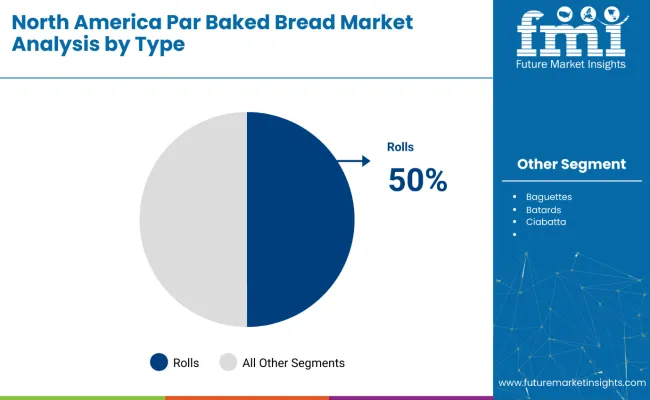
Rolls are projected to dominate par-baked bread sales in 2025, supported by versatile applications across households, foodservice, and retail sectors. Other bread types, including baguettes, batards, and ciabatta, are expected to grow steadily, meeting evolving consumer preferences for variety and specialty baked products.
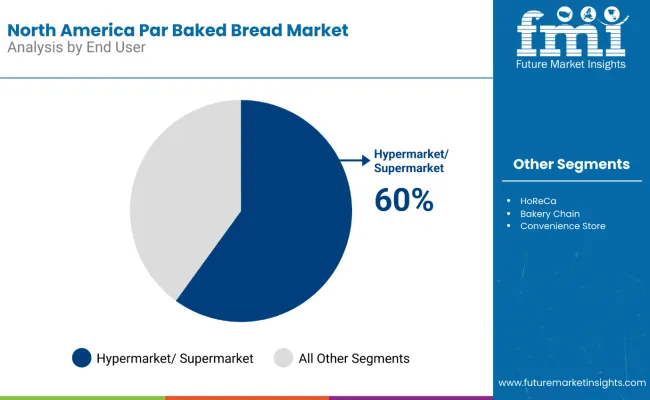
Par baked bread distribution is concentrated in hypermarkets and supermarkets, reflecting strong retail presence, frequent promotions, and consumer trust in branded bakery products. Other end-user segments, including HoReCa, bakery chains, convenience stores, and online platforms, are projected to expand steadily, driven by increasing consumer convenience needs and the growth of takeaway and delivery services.
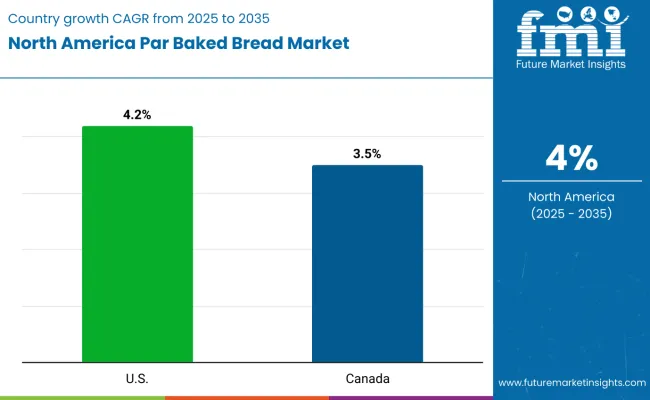
| Countries | CAGR (2025 to 2035) |
| USA | 4.2% |
| Canada | 3.5% |
Strong retail networks, bakery innovations, and high consumer demand in the USA give the country a measurable advantage.At the same time, Canada is expected to register steady growth supported by expanding urban retail channels, rising awareness of convenience bakery products, and an increased presence of bakery chains. The table below shows the compound annual growth rate (CAGR) each of the two countries is expected to record between 2025 and 2035.
Between 2025 and 2035, demand for par-baked bread is projected to expand across both countries. Still, the pace of growth will vary based on retail penetration, bakery innovations, and consumer adoption of convenient bakery products. The USA is expected to maintain the largest market share, driven by its extensive modern retail networks, widespread distribution channels, and continual bakery product innovations. Per capita consumption in the USA is projected to rise steadily from 2025 to 2035, indicating broader adoption of premium and convenience bakery offerings.
Canada, while showing a slightly lower CAGR, is anticipated to grow consistently, supported by the expansion of urban retail infrastructure, increased presence of bakery chains, and rising consumer awareness regarding par baked bread products. Per capita consumption is expected to increase gradually across the country as modern retail and specialty bakery offerings expand.
Collectively, these two countries form the core of par-baked bread demand in North America, highlighting the importance of country-specific strategies in retail penetration, product innovation, and bakery partnerships.
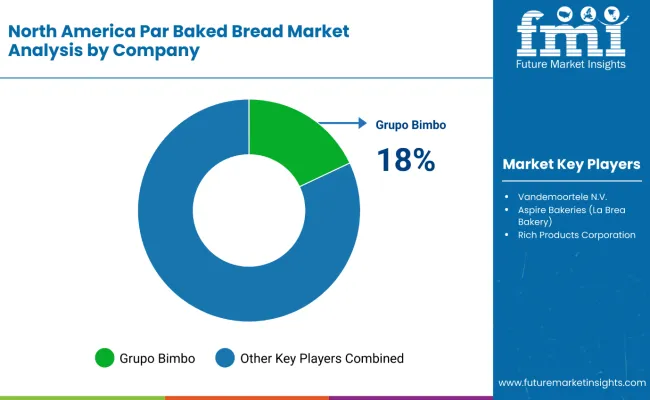
The competitive environment in the North American par-baked bread market is characterized by a mix of large multinational bakery companies and specialized regional players. Operational efficiency, supply chain integration, and strong retail partnerships, rather than product innovation alone, remain decisive success factors: the leading suppliers collectively serve thousands of retail, HoReCa, and industrial clients across North America, maintaining a strong presence in modern and traditional distribution channels.
Grupo Bimbo maintains a dominant position in the region, offering a diversified portfolio of par-baked bread products across multiple formats and end-use applications. The company’s extensive North American distribution network and emphasis on operational efficiency and product innovation provide deep penetration across retail and HoReCa channels.
Vandemoortele N.V., leveraging its expertise in bakery solutions, provides high-quality products catering to both conventional and specialty segments. The company focuses on premium quality, taste, and texture, supporting both retail and foodservice channels with consistent supply and innovation.
Aspire Bakeries (La Brea Bakery) specializes in artisanal and innovative bakery formats, supporting expansion across foodservice and retail sectors. Its emphasis on unique bakery offerings and product differentiation enhances its competitive positioning in premium and specialty segments.
Rich Products Corporation emphasizes par-baked bread solutions for industrial, retail, and HoReCa applications, prioritizing convenience, product quality, and functional bakery innovation. The company’s strong technical support and application-oriented approach reinforce its role as a key player in North America’s bakery landscape.
Private-label initiatives by major distributors are broadening product assortments at competitive pricing, applying pressure on smaller suppliers while ensuring wider access to par-baked bread formats. Consolidation is likely to continue as operational capabilities, retail partnerships, and innovation in bakery solutions remain critical for sustaining market presence and growth in the region.
| Items | Values |
| Quantitative Units (2025) | USD 5.2 billion |
| Type | Rolls, Baguettes, Batards, Ciabatta, Flat Bread, Focaccia, Panini, Others |
| Source | Wheat, Rye, Mixed, Others |
| End-User | HoReCa, Bakery Chains, Hypermarkets/Supermarkets, Convenience Stores, Specialty Stores, Online Retail, Departmental Stores, Others |
| Countries Covered | USA, Canada |
| Key Companies Profiled | Vandemoortele N.V.; Rich Products Corporation; Groupo Bimbo; ASPIRE BAKERIES (La Brea Bakery); Campbell Soup; Sysco Corporation (Baker Source); Dr. Schar USA Inc.; TURANO BAKING CO; Delifrance ; Lantmannen Unibake USA; La Brea Bakery; ACE Bakery; Stonefire Authentic Flatbreads; Readi -Bake; Klosterman Baking Company |
| Additional Attributes | Dollar sales by product type and flavor, regional demand trends, premiumization in dairy powders, influence of clean-label trends, impact of sustainability on manufacturing & packaging, rise of plant-based yogurt powders, and competitive strategies focusing on taste, texture, and nutritional fortification |
The global north america par baked bread market is estimated to be valued at USD 5.6 billion in 2025.
The market size for the north america par baked bread market is projected to reach USD 8.3 billion by 2035.
The north america par baked bread market is expected to grow at a 4.0% CAGR between 2025 and 2035.
The key product types in north america par baked bread market are rolls, baguettes, batards, ciabatta, flat bread, focaccia, panini and others.
In terms of source, wheat segment to command 54.2% share in the north america par baked bread market in 2025.






Our Research Products

The "Full Research Suite" delivers actionable market intel, deep dives on markets or technologies, so clients act faster, cut risk, and unlock growth.

The Leaderboard benchmarks and ranks top vendors, classifying them as Established Leaders, Leading Challengers, or Disruptors & Challengers.

Locates where complements amplify value and substitutes erode it, forecasting net impact by horizon

We deliver granular, decision-grade intel: market sizing, 5-year forecasts, pricing, adoption, usage, revenue, and operational KPIs—plus competitor tracking, regulation, and value chains—across 60 countries broadly.

Spot the shifts before they hit your P&L. We track inflection points, adoption curves, pricing moves, and ecosystem plays to show where demand is heading, why it is changing, and what to do next across high-growth markets and disruptive tech

Real-time reads of user behavior. We track shifting priorities, perceptions of today’s and next-gen services, and provider experience, then pace how fast tech moves from trial to adoption, blending buyer, consumer, and channel inputs with social signals (#WhySwitch, #UX).

Partner with our analyst team to build a custom report designed around your business priorities. From analysing market trends to assessing competitors or crafting bespoke datasets, we tailor insights to your needs.
Supplier Intelligence
Discovery & Profiling
Capacity & Footprint
Performance & Risk
Compliance & Governance
Commercial Readiness
Who Supplies Whom
Scorecards & Shortlists
Playbooks & Docs
Category Intelligence
Definition & Scope
Demand & Use Cases
Cost Drivers
Market Structure
Supply Chain Map
Trade & Policy
Operating Norms
Deliverables
Buyer Intelligence
Account Basics
Spend & Scope
Procurement Model
Vendor Requirements
Terms & Policies
Entry Strategy
Pain Points & Triggers
Outputs
Pricing Analysis
Benchmarks
Trends
Should-Cost
Indexation
Landed Cost
Commercial Terms
Deliverables
Brand Analysis
Positioning & Value Prop
Share & Presence
Customer Evidence
Go-to-Market
Digital & Reputation
Compliance & Trust
KPIs & Gaps
Outputs
Full Research Suite comprises of:
Market outlook & trends analysis
Interviews & case studies
Strategic recommendations
Vendor profiles & capabilities analysis
5-year forecasts
8 regions and 60+ country-level data splits
Market segment data splits
12 months of continuous data updates
DELIVERED AS:
PDF EXCEL ONLINE
Northern Blotting Market Size and Share Forecast Outlook 2025 to 2035
Northern Europe Calcium Sulphate Market Size and Share Forecast Outlook 2025 to 2035
North America Boat Trailer Market Size and Share Forecast Outlook 2025 to 2035
North America Cryogenic Label Printer Market Size and Share Forecast Outlook 2025 to 2035
North America Chitosan Market Size and Share Forecast Outlook 2025 to 2035
North America Underground Mining Vehicle Market Size and Share Forecast Outlook 2025 to 2035
North America Bulk Aseptic Packaging Market Size and Share Forecast Outlook 2025 to 2035
North America Licorice Extract Market Size and Share Forecast Outlook 2025 to 2035
North America Silo Bags Market Size and Share Forecast Outlook 2025 to 2035
North America Fresh Meat Packaging Market Size and Share Forecast Outlook 2025 to 2035
North America Ceramic Barbeque Grill Market Size and Share Forecast Outlook 2025 to 2035
North America Temperature Sensor Market Size and Share Forecast Outlook 2025 to 2035
North American Dietary Supplements Market Size and Share Forecast Outlook 2025 to 2035
North America Head-up Display Market Size and Share Forecast Outlook 2025 to 2035
North America, Europe & Asia Pacific Legal Cannabis Market Size and Share Forecast Outlook 2025 to 2035
North America Ceiling Cassette Market Size and Share Forecast Outlook 2025 to 2035
North America Pressure Regulating Valves Market Size and Share Forecast Outlook 2025 to 2035
North America Flame Retardant Thermoplastics Market Size and Share Forecast Outlook 2025 to 2035
Fire Pit Market Analysis in North America - Growth, Trends and Forecast from 2025 to 2035
North America Electrical Testing Services Market - Growth & Demand 2025 to 2035

Thank you!
You will receive an email from our Business Development Manager. Please be sure to check your SPAM/JUNK folder too.
Chat With
MaRIA